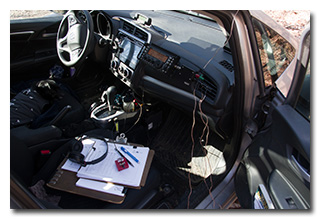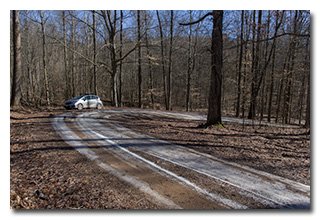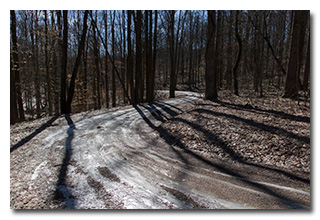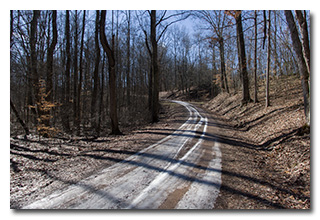
by William Eric McFadden
From the wildlife area's website:
-
Turkey Ridge provides access to Raccoon Creek allowing angling opportunities for largemouth bass, bullhead catfish, and bluegill. The major game species are cottontail rabbit, white-tailed deer, turkey, ruffed grouse, and squirrel. Most all furbearers common to the region also occur on the area. A variety of songbirds, reptiles, and amphibians also live on the area in association with the mixture of habitat types.
Pictures
- Eric's station: 1 | 2
- Bolster Hollow Road: looking down the hill & looking up the hill
Description
On Saturday, February 1, 2024, one member of the Southeast Ohio Radio Adventure Team (SEORAT) performed a successful activation of Turkey Ridge Wildlife Area in Ohio as part of the Parks on the Air (POTA; link) program.
Following a successful two-fer activation of Lake Hope State Park and Zaleski State Forest while participating in the Arizona ScQRPions Freeze Your B___ Off (FYBO; link) field operating event (report, Eric McFadden, WD8RIF, performed an impromptu POTA activation of Turkey Ridge Wildlife Area on Bolster Hollow Road, a road formerly used as an SCCA Pro Rally stage road in the Sunriser 400 Pro Rally and as an American Rally Association (link) stage road in the Southern Ohio Forest Rally (link). Eric was accompanied by his little dog Theo.
After successfully making their way up the treacherously muddy and icy Bolster Hollow Road, Eric and Theo arrived at the at the hairpin curve on Bolster Hollow Road at about 1715 UTC. After taking Theo for a quick walk, Eric deployed his 28½' end-fed random wire antenna as a vertical supported on a 31' Jackite telescoping fiberglass mast in a drive-on base, laying out three 17' counterpoise wires directly on the ground. Mounting his KX3 on his car's passenger-side dash, Eric was on the air at 1731 UTC.
Eric chose to not perform this operation as a continuation of his earlier FYBO operation but to operate it as a straight POTA activation.
As at his previous activations of this unit, Eric had only minimal cell-signal at the operating location, enough, perhaps, to send and receive text-messages but not to spot himself on POTA Spots (link) or to use POTA Spots to look for park-to-park (P2P) QSO opportunities. Before leaving his previous operating location in Lake Hope State Park, Eric had announced his upcoming activation on POTA Spots so that he might be auto-spotted on POTA Spots once he was heard calling CQ.
Eric began operations on 20m by finding a clear frequency to run and calling "CQ POTA". The auto-spot system must have worked because his first QSO came at 1732 UTC with W5KEB in Arkansas. QSOs came quickly, with Eric's seventeenth QSO coming at 1748 UTC with KA3ICJ in Maryland. This run included a P2P QSO with K2ZMM at Morristown National Historical Park (US-0746) in New Jersey and QSOs with operators located in Arkansas, Florida, Georgia, Illinois (2), Maine, Maryland, New Hampshire, New Jersey (2), New York, North Carolina, Ontario, Pennsylvania, South Dakota, Tennessee, and Texas.
Switching to 40m, Eric found a clear frequency to run, began calling "CQ POTA", and was again, apparently, auto-spotted on POTA Spots. His first QSO in this run came at 1752 UTC with W0CGC in Tennessee. QSOs again came quickly, with Eric's ninth QSO in this run coming at 1802 UTC with KI8FV in nearby McArthur, Ohio. This run included QSOs with operators located in Indiana, New Jersey, North Carolina (2), Ohio (2), South Carolina, Tennessee, and Wisconsin.
Eric was pleased to have worked his good friend Thomas, K4SWL, on both the 20 and 40m bands.
In all, Eric made twenty-six QSOs, including one P2P QSO, in thirty-one minutes of on-air time. All QSOs were CW and were made at five watts output.
(return)



